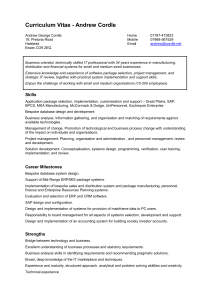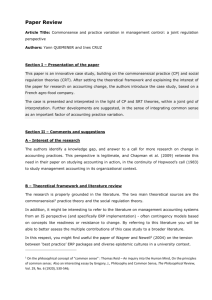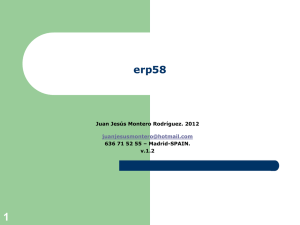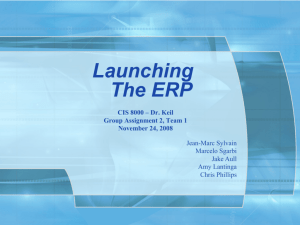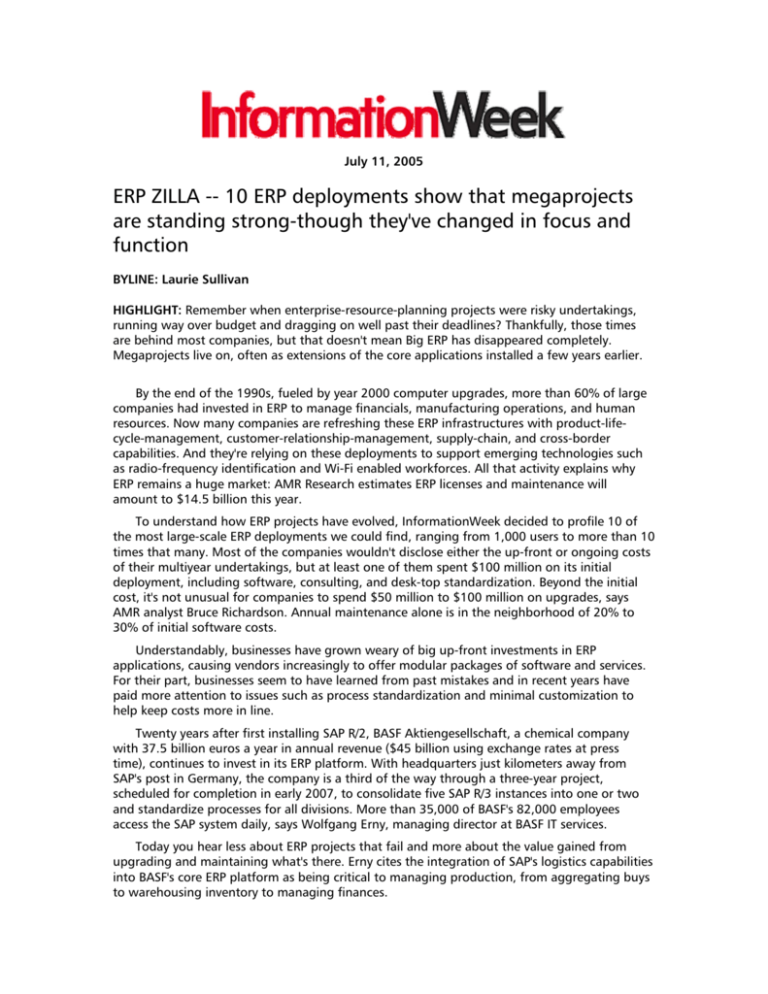
July 11, 2005
ERP ZILLA -- 10 ERP deployments show that megaprojects
are standing strong-though they've changed in focus and
function
BYLINE: Laurie Sullivan
HIGHLIGHT: Remember when enterprise-resource-planning projects were risky undertakings,
running way over budget and dragging on well past their deadlines? Thankfully, those times
are behind most companies, but that doesn't mean Big ERP has disappeared completely.
Megaprojects live on, often as extensions of the core applications installed a few years earlier.
By the end of the 1990s, fueled by year 2000 computer upgrades, more than 60% of large
companies had invested in ERP to manage financials, manufacturing operations, and human
resources. Now many companies are refreshing these ERP infrastructures with product-lifecycle-management, customer-relationship-management, supply-chain, and cross-border
capabilities. And they're relying on these deployments to support emerging technologies such
as radio-frequency identification and Wi-Fi enabled workforces. All that activity explains why
ERP remains a huge market: AMR Research estimates ERP licenses and maintenance will
amount to $14.5 billion this year.
To understand how ERP projects have evolved, InformationWeek decided to profile 10 of
the most large-scale ERP deployments we could find, ranging from 1,000 users to more than 10
times that many. Most of the companies wouldn't disclose either the up-front or ongoing costs
of their multiyear undertakings, but at least one of them spent $100 million on its initial
deployment, including software, consulting, and desk-top standardization. Beyond the initial
cost, it's not unusual for companies to spend $50 million to $100 million on upgrades, says
AMR analyst Bruce Richardson. Annual maintenance alone is in the neighborhood of 20% to
30% of initial software costs.
Understandably, businesses have grown weary of big up-front investments in ERP
applications, causing vendors increasingly to offer modular packages of software and services.
For their part, businesses seem to have learned from past mistakes and in recent years have
paid more attention to issues such as process standardization and minimal customization to
help keep costs more in line.
Twenty years after first installing SAP R/2, BASF Aktiengesellschaft, a chemical company
with 37.5 billion euros a year in annual revenue ($45 billion using exchange rates at press
time), continues to invest in its ERP platform. With headquarters just kilometers away from
SAP's post in Germany, the company is a third of the way through a three-year project,
scheduled for completion in early 2007, to consolidate five SAP R/3 instances into one or two
and standardize processes for all divisions. More than 35,000 of BASF's 82,000 employees
access the SAP system daily, says Wolfgang Erny, managing director at BASF IT services.
Today you hear less about ERP projects that fail and more about the value gained from
upgrading and maintaining what's there. Erny cites the integration of SAP's logistics capabilities
into BASF's core ERP platform as being critical to managing production, from aggregating buys
to warehousing inventory to managing finances.
Appliance manufacturer Whirlpool Corp.-which began its SAP ERP deployment about five
years ago and continues implementations as it opens offices in new corners of the worldbelieves the value of ERP today is in helping to drive innovation and initiate change. Whirlpool
has deployed a single instance of SAP's ERP suite and closes the books for 98% of its businesses
on the vendor's financials platform.
The 30-year high in prices of commodities such as steel and copper, combined with record
oil prices and a global logistics capacity stretched thin by demand coming from Asia and India,
created conditions that put heavy pressure on Whirlpool's margins last year. The company
concluded that to manage its margins in this environment, a 5% to 8% increase in prices was
needed globally on its products-the first increase in 10 years. "In order to manage and
implement those price in- creases, we had to have the capability to see product by product,
category by category, country by country, day to day, the impact of materials costs, logistics
costs, and the impact into our margins," says corporate VP and CIO Esat Sezer.
In November, the company leveraged its ERP foundation and used SAP's Business
Warehouse to deliver the necessary visibility on a global scale, and it was testing the project by
January. "You were never able to do that at that speed and pace without having an ERP
infrastructure like we have today," Sezer says.
In the case of Del Monte Foods Co., its ERP deployment is driving its ability to meet WalMart Stores Inc.'s and Target Corp.'s RFID mandates to their suppliers. Del Monte in 2003 began
replacing more than 70 legacy systems on a variety of platforms with one instance of SSA
Global Technologies Inc.'s ERP software on an IBM AS/400. Now it's tying an RFID application
into SSA Global's ERP platform, which is known as SSA ERP LX. "ERP is the solid base from
which we plug in specific applications and processes that drive innovation such as data
synchronization, RFID, procurement, transportation management, and other critical functions,"
says CIO Marc Brown.
With operations primarily in North America, Latin America, American Samoa, and the
Philippines and just 1,200 users, Del Monte has the smallest of the ERP deployments profiled
here. But it's not underestimating the value of the tools, including the EXE Warehouse
Management module deployed just last year, as it focuses on its supply-chain-management
processes to become a more demand-driven company.
At the other end of the spectrum is Alcoa Inc., the largest aluminum company in the world
with revenue of $23.5 billion a year and operations that stretch across 41 countries and 500
locations, including 350 manufacturing plants. It boasts more than 10,000 users of its Oraclebased ERP deployment, and it's not done yet. The deployment of Oracle requisition-to-pay and
finance processes began in Europe in 2001; they wrapped last year. The company this year will
complete an Oracle HR implementation across most of its operations except North America,
and it expects to be 60% complete implementing its order-to-cash processes by year's end, as
well.
Alcoa started with an organization in which line-of-business presidents had responsibility
for everything from profit and loss to software selection and IS infrastructure, a setup that led
to duplications and inefficiencies. In the new organization, most back-office service functions
exist as part of a global shared-business-services model. One example of how far the
centralized ERP system has already taken the company: Alcoa North America CIO Kevin Horner
cites the savings it has achieved in procurement. Using the Hackett Group's benchmarks to
measure its procurement costs against spending, the ratio went down by almost 25%.
"We would suggest that the common optimized processes and common configuration of
the software across the company and across the world is a major enabler to drive that home,"
Horner says. "There's no way we could have ever driven that level of savings in North America
alone with 44 different procurement systems." To wring further value out of its procurement
processes, in April Alcoa unveiled the creation of a global procurement organization that will
take advantage of the common data platform to analyze which commodities the company buys
and from whom.
Getting to those common processes and data is also a challenge for the $73 billion-a-year
home-improvement retailer Home Depot Inc. It has spent $1 billion to modernize its IT
infrastructure and in-store technology, and next month the company will add to that with the
installation of SAP for Retail, which includes applications for merchandising and supply-chain
management and ties into the company's SAP Financials module. The move will centralize and
consolidate 15 order-management systems into one to support the entire enterprise and
improve electronic collaboration with suppliers. "We are one of [SAP's] biggest and most
cumbersome customers," says Bob DeRodes, executive VP and CIO at Home Depot, noting that
the current system is "fraught with error."
One rule other companies have followed to ensure that their systems aren't fraught with
errors is to keep implementations simple. Companies spent years debating whether to
customize ERP apps, with analysts and vendors, Oracle in particular, leading the charge against
the practice. Now, it seems, Oracle and company were right all along. Dow Corning, for
instance, runs its SAP ERP system, which at peak times is accessed simultaneously by 1,500
users, with as few modifications as possible.
"We had seen others go down the path of modifying the system to the point that it became
their own," CIO Abbe Mulders says. "But then they couldn't keep up with it. So we said no
mods." The only changes Dow Corning has made are those that don't fundamentally alter SAP's
own code. "When the last sites went live, we had less than 50 modifications, and they were all
approved by SAP. That was pretty impressive." The same is true at Alcoa, which says it hasn't
changed a line of Oracle code as it has gone through its implementations; it writes interfaces
only as needed and specific extensions when Oracle's software doesn't align with direct
business requirements.
It's a similar situation at FedEx Corp., which runs one instance of Oracle's PeopleSoft ERP
apps, including financials, human resources, inventory, asset management, E-procurement, and
expense reporting, for its Express business and its international entities and another for
corporate services, freight, and Kinko's, says Scot Struminger, VP of corporate headquarters.
"The value proposition is about trying to stay vanilla and not be creative and develop
respectable processes," he says. "The creative is in the products, services, and people."
Companies have taken different approaches to the number of ERP instances they run. Dow
Corning Corp., for example, runs at its headquarters a single instance of the enterprise system
that's used around the world. A single instance is one main data source that all the ERP systems
in a company use. Automaker DaimlerChrysler AG runs about 100 instances of SAP modules,
having decided to split its deployments into clusters when Daimler Benz and Chrysler merged in
the mid-1990s, because it wasn't clear the software and architecture would support so many
transactions on a single instance, says Michael Gorriz, CIO of the Mercedes car group and
business system at DaimlerChrysler. Systems talk to each other by standard interfaces that SAP
supports.
It's clear today that scalability wouldn't be a problem, though, "and if we were to start from
scratch, we'd probably concentrate more of the SAP into single instances," he says. But that
would require more investment than the automaker wants to make for systems that run well
and are well-supported, even as it expands and upgrades its ERP infrastructure, which is based
mostly on R/3 release 4.6C but will migrate to mySAP within five years. Most recently,
DaimlerChrysler deployed an SAP cluster in Singapore that serves 11 Asian countries, and it's
adding 15 European countries in a cluster that will be supported from Stuttgart, Germany.
FedEx didn't start out with a global deployment of its PeopleSoft applications, so it, too,
began with multiple instances of the software. But as FedEx learned ERP and got better at it,
the company concluded that it didn't want to manage all those instances. "There is so much to
be gained on this common set of practices that we began to shrink those into single instances,"
Struminger says.
Going forward, companies like these are considering how to take advantage of the next set
of changes coming from vendors. These include Oracle's plans to add business insight via
embedded analytics and management reporting in its own applications as well as those it has
acquired from PeopleSoft, and SAP's move to component-based architectures for its NetWeaver
middleware. "NetWeaver is very interesting to us," says Gorriz of DaimlerChrysler, describing an
"ideal world" in which NetWeaver is able to be combined with Java extensions to easily
integrate other applications and trading partners.
Microsoft is garnering increasing interest as an ERP vendor, as well, taking its place among
the top five suppliers in terms of ERP revenue in 2004. The vendor plans to transition its
Axapta, Great Plains, Navision, and Solomon ERP platforms to a common architecture and code
base in the next few years.
Obviously, there's always more to do on companies' venerable ERP platforms. "There is no
steady state for ERP, because you're always looking for upgrades and improvements," says
Whirlpool's Sezer. "As new business developments continue, so will the implementations." -with
Jennifer Zaino and Beth Bacheldor
Write to Laurie Sullivan at lsullivan@cmp.com. Visit our Business
Applications Tech Center: informationweek.com/TC/sw/bizapps
--1) Alcoa
Primary ERP provider: Oracle
2004 REVENUE $23.5 billion
EMPLOYEES 129,000 worldwide
pay
MODULES OR FUNCTIONS USED Financials, human resources, order to cash, requisition to
DEPLOYMENT DETAILS Began in 2001 with financials and requisition-to-pay processes at 50
locations in Europe; those are now live across Europe, North America, Australia, Asia, and Latin
America. HR processes are complete in Australia and by end of year are expected to be
complete in Europe and Latin America. At year's end, order-to-cash processes should be about
60% complete worldwide.
NUMBER OF USERS More than 10,000
2) BASF Aktiengesellschaft
Primary ERP provider: SAP
2004 REVENUE 37.5 billion euros
EMPLOYEES 82,000 worldwide
MODULES OR FUNCTIONS USED Full suite
DEPLOYMENT DETAILS Began at the end of the 1980s and completed in early 1990s. There
have been about 10 upgrades in the last few years, most recently updating many systems to
R/3 v. 4.7. Now BASF is a third of the way through a project that's scheduled to be done in early
2007, consolidating multiple instances to one or two and standardizing processes.
NUMBER OF USERS 35,000
3) Capital One Financial
Primary ERP provider: Oracle
2004 REVENUE $1.5 billion
EMPLOYEES 15,000
MODULES OR FUNCTIONS USED PeopleSoft financials, human resources, supply chain, asset
management Deployment details Began in 2000, focusing on piloting financials in the U.K. HR
implementation in the U.K. followed and then U.S. deployment. In 2002, after stabilizing the
system, Capital One began a second round of HR and financials-conversion projects for process
optimization. A single instance is used by all except U.K. financials, which integrate in roll-up
mode. Deployment of BEA Systems-based portal for ERP access was completed in 2004.
NUMBER OF USERS 18,000
COST Tens of millions of dollars
4) Colgate-Palmolive
Primary ERP provider: SAP
2004 REVENUE $10.6 billion
EMPLOYEES 36,000
MODULES OR FUNCTIONS USED Supply-chain, customer-relationship, supplier-relationship,
and human-resources management; financials; composite applications; order processing; bill of
materials; manufacturing; employee self-service, and others
DEPLOYMENT DETAILS First pilot went live in 1996. There have been two major upgrades in
nine years, and the company continues to roll out SAP R/3, mySAP's Advanced Planning and
Optimization, CRM, SAP Portals, and Business Warehouse. Colgate-Palmolive runs five R/3
instances in Europe, North America, Latin America, Asia-South Pacific, and for its Hill's Science
Diet brand. There's one global HR system. SAP Business Warehouse database housing all
customer data for the various applications is 6 terabytes.
NUMBER OF USERS 15,000
5) DaimlerChrysler
Primary ERP provider: SAP
2004 REVENUE 142.1 billion euros
EMPLOYEES 384,723 worldwide
MODULES OR FUNCTIONS USED Finance, production, logistics
DEPLOYMENT DETAILS Daimler Benz and Chrysler began separate implementations of the
R/3 finance modules before the 1996-'97 merger, and these remain separate instances.
Mercedes division in 2002 began deploying a separate instance of SAP for production and
logistics. SAP clusters throughout DaimlerChrysler, which total about 320 installations and 100
instances of SAP modules, include Asia, where 11 countries are on one instance. An expansion
to 15 countries in Europe is next. Most instances are based on R/3 Release 4.6C. NUMBER OF
USERS 50,000 worldwide
6) Del Monte Foods
Primary ERP provider: SSA Global Technologies
2004 REVENUE $3 billion
EMPLOYEES 8,500 full time and 9,800 seasonal in U.S., Latin America, Canada, Mexico, the
Philippines, and American Samoa Modules Or functions used Business Planning and Control
System ERP suite
DEPLOYMENT DETAILS Began in 2003 with one instance on an IBM AS/400 running DB2
that replaced more than 70 legacy systems on a variety of platforms shortly after Del Monte
merged with several businesses that had been spun out of H.J. Heinz Co. Spins-offs already
were running SSA Global ERP software. The most recent deployment was the 2004 rollout of
the EXE Warehouse Management Module.
NUMBER OF USERS 1,200
7) Dow Corning
Primary ERP provider: sap
2004 REVENUE $3.37 billion
EMPLOYEES 8,800 worldwide
MODULES OR FUNCTIONS USED Supply-chain, customer-relationship, supplier-relationship,
and human-resources management; financials; order processing; composite apps;
manufacturing; bill of materials; employee self-service; and others Deployment details Initial
project began in 1996 and was completed in late 1998. The most recent update was in June,
putting in SAP ERP core components 5.0. At its headquarters, Dow Corning runs a single
instance of the enterprise system that's used around the world. The database, SAP Business
Warehouse, houses all customer data used by the different apps and has grown into the
terabytes
NUMBER OF USERS Almost all Dow Corning employees use the system in one way or
another. During peak times, about 1,500 employees actively use it.
COST $100 million
8) FedEx
Primary ERP provider: oracle
2005 Revenue $29 billion
EMPLOYEES More than 250,000 worldwide (including contractors)
MODULES OR FUNCTIONS USED PeopleSoft asset management, general ledger, financials,
human resources, E-procurement, expense reporting, inventory, project costing, and others
DEPLOYMENT DETAILS Began with PeopleSoft general-ledger and asset-management
software in 1997. After two major upgrades in last few years, the most recent in 2004, system
includes 12 PeopleSoft modules. FedEx's Express domestic and international operations run on
one instance. Corporate Services, Ground, Freight, and Kinko's run another instance.
NUMBER OF USERS More than 20,000
9) Home Depot
Primary ERP provider: sap
2004 REVENUE $73 billion
EMPLOYEES 325,000 worldwide
MODULES OR FUNCTIONS USED SAP Financials, SAP for Retail
DEPLOYMENT DETAILS Began with SAP Financials. Most recent deployment was to install
SAP for Retail.
10) Whirlpool
Primary ERP provider: sap
2004 REVENUE $13.2 billion
EMPLOYEES 68,000 worldwide
MODULES OR FUNCTIONS USED Full suite
DEPLOYMENT DETAILS Began in 1999 and 2000 in North America with Finished-Goods
forward processes (excluding Manufacturing processes). Today 98% of business closes its books
on SAP's platform. Whirlpool is working on adding Production Planning modules, as well as
suite implementations in smaller countries. A single instance of the system at the company's
headquarters is used around the world. An IBM DB2 database supports the applications and
has grown into the terabytes.
NUMBER OF USERS Close to 10,000
--GLOBAL SMARTS
Colgate-Palmolive finesses procurement
As Colgate-Palmolive Co. expanded its global presence in the '90s, it became clear that
disparate systems around the world and the inability to see inventory in real time was
hampering its ability to "enter into the adventure," CIO Ed Toben says. That's when the
company opted for standardizing on SAP's core ERP suite from distribution to manufacturing to
finance to human resources. "We went from many applications-quite frankly we couldn't count
them all-into a core SAP R/3 platform in five deployments around the world," Toben says.
The strategy worked. About 70% of Colgate-Palmolive's $1.32 billion net income on more
than $10.6 billion in annual revenue last year came from sales outside the United States. With
so much business being done outside U.S. borders, the company is taking greater advantage of
the Advanced Planning and Optimization module, a component of mySAP's supply-chain
software that includes demand and production planning. The module will help ColgatePalmolive move to regional-procurement systems for the direct materials it uses to manufacture
products from toothpaste to pet food and for indirect products used throughout the company,
such as computers and paper. Colgate began installing the module in 1998, even before it
completed the first phase of its worldwide R/3 rollout that now extends to 15,000 users.
As Colgate has pushed its global R/3 model forward, it has made sure to define and
standardize core tasks of more than 100 business processes. "A huge advantage is that, in time,
the process matures and improves," says Toben, and newer deployments can leverage the
lessons the company learned from earlier ones.
On Colgate's plate now is upgrading to SAP's NetWeaver integration technology. SAP
modules beyond the core R/3 functions, such as the business-warehouse, supply-chain, and
CRM systems, aren't fully integrated with the traditional R/3 ERP functions, Toben says, so using
NetWeaver "to try to have a more seamless process of 'weaving' all that together makes sense
to us." -Laurie Sullivan
15,000 Number of users in the worldwide R/3 rollout
--INNOVATION ENGINE
Dow Corning invests in change
Dow Corning Corp.'s enterprise-resource-planning system, now 9 years old, supports the
company's vital supply-chain, human-resources, and financials processes and still serves as the
foundation for innovative new business processes. "Any of our general business managers will
tell you that SAP is a pivotal part of Dow Corning today," says Abbe Mulders, executive VP and
CIO of the $3.4 billion-a-year chemicals company.
Last year the ERP software was central in two major projects to let customers place orders
on the Web. Mulders and her team first built an online site to sell the Xiameter brands, which is
a collection of products sold in bulk, including silicone fluids and rubbers. "Because we had
SAP, we were able to put up the Web site and launch order-entry capability in less than seven
months," Mulders says.
The IT team then re-created the model for its Dow Corning brands, a more complex group
of products that meet specific needs of customers ranging from small specialty shops to billiondollar corporations. "To build a Web site and order capability that bridges across that vast span
of a customer base was quite a feat. SAP was the backbone that allowed us to do that,"
Mulders says.
The 300-person IT team focuses most of its ERP-related time and dollars on new
development, not maintenance. "We support that innovation and changing business needs
with 60% to 65% of our resources toward new projects," Mulders says.
The company began implementing the ERP software in 1996. Two years and about $100
million later, it finished the bulk of the implementation. The following year, Dow Corning
added SAP's human-resources-management software. Since then, it has upgraded the system-a
single instance housed in Dow Corning's Midland, Mich., headquarters-about five times. The
customer database is "in the terabytes" now, Mulders says, and at peak times some 1,500 users
simultaneously access the various applications from around the world. -Beth Bacheldor
$100 million Cost of implementing SAP's ERP software
--MODERN WORKFORCE
Capital One puts ERP at core of work
Just five years ago at Capital One Financial Corp., it took 10 human-resources specialists to
sign off on one change-of-address form. With thousands of employees worldwide, that's a lot
of paper-pushing. Today, address changes are done via a self-service application that has freed
HR to devote time to strategic staffing, program planning, and change management.
This example illustrates a big change that has taken place at the $1.5 billion-a-year
financial-services company since it began rolling out PeopleSoft applications. "It's a cultural
change that has freed people to not deal with minutiae but to deal with business value," says
Gregor Bailar, executive VP and CIO. "It really has been transformative." Bailar envisions more
automation ahead, with financials following in the footsteps of HR's "lean-process" design to
deal with the mountain of data requests the financials team receives and processes within the
group.
The PeopleSoft ERP system, which serves as Capital One's backbone for financials, HR, assetmanagement, and supply-chain processes, supports about 18,000 users, including Capital One's
15,000 associates and some business partners. The apps are accessible via a Web portal based
on BEA Systems Inc.'s technology.
Capital One is exploring the possibility of partnering with ERP application service providers,
now that the hard work of correcting data and linking processes is done. Running the
applications may be more of a commodity job at this point, but the applications themselves
serve as a pillar for the company's future-of-work initiative. Bailar describes this as "a very
mobile, interactive, collaborative environment" designed to support the requirements of the
company's biggest asset, its knowledge workers. It's characterized not only by extensive Wi-Fi
access, VoIP-enabled laptops, instant messaging, and BlackBerrys, but also by workflows that,
for the most part, come to users electronically. Says Bailar, "Everyone's daily life is kind of drawn
back to this suite of apps." -Jennifer Zaino
18,000 Number of users ERP system supports
For more on ERP, see the following online:
- Forrester Research's analysis of the latest ERP trends: informationweek.com/
1047/hammerman.htm
- Find out what your peers' ERP deployment plans are in exclusive research:
informationweek.com/ 1047/charts.htm
- ERP sites you should know about: informationweek.com/ 1047/sites.htm
http://informationweek.com/
Copyright (c) 2005 CMP Media LLC. All rights reserved.


